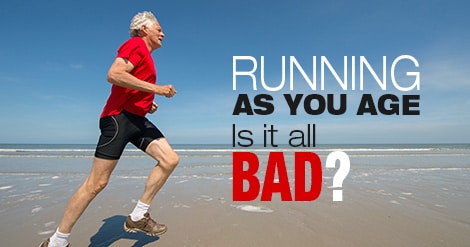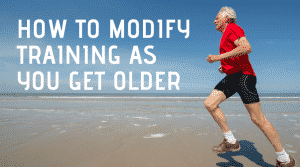In the past, we wrote an article on how children can be compared to a spring in the way they run.
By looking at the way children run, and then monitoring the changes as they grow, we hoped to find some useful insights into our own biomechanics.
Today, we are going to follow runners at the opposite end of the spectrum by looking at how running mechanics changes as you age.
If you are an older runner, in your fifties, sixties, or even seventies, do your mechanics fundamentally change compared to a younger runner?

Biomechanical differences
It is no secret that runners do eventually slow down as they age. After the age of forty, runners slow by an average of 1-6 seconds per mile,1, 2, depending on the race distance.
Research published in 2008 by Italian and Brazilian researchers Giovanni Cavagna, Mario Legramandi, and Leonardo Peyré-Tartaruga attempted to illuminate the biomechanical changes that occur in older runners.3
Cavagna et al. recruited eight healthy men in their late sixties to seventies, three of whom were trained runners.
The researchers had the men run at different speeds along a fifty-meter runway, recording data about their impact forces, and the motion of their joints. The running mechanics of the older men were compared to the same tests on running-mechanics of college-aged men. Again, three of these subjects were also trained runners.
By examining the differences in running mechanics at a broad range of running speeds (as slow as a thirty-minute mile shuffle and as fast as 5:40 mile pace in the older subjects!), Cavagna, Legramandi, and Peyré-Tartaruga were able to demonstrate certain similarities and differences between the older and younger runners.
Muscular Power
The older runners were not able to generate nearly as much vertical “push” off the ground as the younger runners because of their decreased ability to generate muscular power.
In fact, younger runners were able to attain a 75% higher peak vertical acceleration when running at high speeds compared to the older runners.
This lack of muscular power has significant implications on the biomechanics. Younger runners generate vertical power to adopt a longer “loping” stride that spends more time in the air than on the ground.
Older runners cannot generate the same muscular power, and are therefore forced to adopt a much higher stride frequency to run at faster speeds.
In this sense, the concept of the “old man shuffle” has some truth to it.
The inability of older runners to generate enough vertical power to enable an “asymmetric stride”—one which spends more time in the air than on the ground—implies that their efficiency is diminished significantly at speeds faster than 8:45 per mile. This is the point where the most optimal stride patterns change to a floating, asymmetric pattern.
Stride Frequency
An additional barrier to efficient running comes as a result of the higher stride frequency: with less time spent in the air, there is also less time for an older runner to swing his or her legs forward, meaning the “shuffle” must be very quick and inefficient. At higher speeds, this importance is magnified.
Compared to younger runners, older runners become even more inefficient as speeds increase.
If your goal is to avoid or limit these age-related changes in running efficiency, it is pretty clear that you should aim to build or at least maintain your muscular strength.
Cavagna, Legramandi, and Peyré-Tartaruga identify two main reasons why older runners (and older people in general) cannot generate as much muscular power: loss of muscle mass and loss of force production at the cellular level in the muscles. Weight training should address both of these issues.
Conclusion
While these studies do highlight some of the negatives of aging, they do provide us with some very important takeaways (and even some positives).
Most importantly, if you are over the age of fifty, and you are not lifting weights once or twice a week, you should be!
Your focus should be on increasing the strength of the major propulsion and power muscles in your legs: the glutes, hamstrings, and calves. These muscles are what generate power during your running stride (here’s how). Keeping them strong will hopefully stave off the age-related changes in running mechanics.
From what we can gather, the physiology of training itself doesn’t change much as you age.
Sure, you’ll have to slow your workouts down a bit. However, your approach to training itself doesn’t need to change much. You still need to target the same energy systems, find the right balance of work at your 3 different thresholds, find the right mileage, and keep up the speed development work.
Finally, there might be a silver lining to these changes; a higher stride frequency implies less force going through the body with each step, which might explain why older runners have a lower incidence of many common running injuries.4
So, getting older does not mean all bad news, especially if you follow this advice and understand the limitations!




One Response
My spouse and I stumbled over here from a different website and thought I may as well check things out.
I like what I see so now i’m following you. Look forward to
exploring your web page yet again.